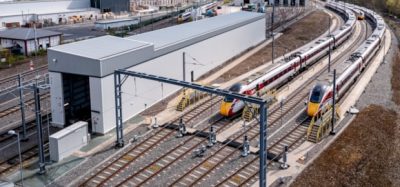£100m investment signals new start for Nottingham
Posted: 29 November 2012 | | No comments yet
It is not often in the life of a Route Managing Director that you get to install a whole new track layout through a major station, but between September 2012 and December 2013, Nottingham’s railway station will be rebuilt complete with a new £100 million track layout and resignalling scheme.
Another scheme, which will finish later, will see the city’s tram network extended and a station built over the top – the first major work to be completed on the station since it was built in 1903.
Nottingham, like so many other places across Europe, has seen its railway infrastructure shrink over the last half century. It once hosted two central main line stations (Victoria and Midland), plus two others run by the Great Northern. They all closed – with Victoria the last to go in 1967.
For many years, the five platforms of the former Midland station were able to cope with traffic, but now with steady growth in rail traffic we have a new challenge.
It is not often in the life of a Route Managing Director that you get to install a whole new track layout through a major station, but between September 2012 and December 2013, Nottingham’s railway station will be rebuilt complete with a new £100 million track layout and resignalling scheme. Another scheme, which will finish later, will see the city’s tram network extended and a station built over the top – the first major work to be completed on the station since it was built in 1903. Nottingham, like so many other places across Europe, has seen its railway infrastructure shrink over the last half century. It once hosted two central main line stations (Victoria and Midland), plus two others run by the Great Northern. They all closed – with Victoria the last to go in 1967. For many years, the five platforms of the former Midland station were able to cope with traffic, but now with steady growth in rail traffic we have a new challenge.
It is not often in the life of a Route Managing Director that you get to install a whole new track layout through a major station, but between September 2012 and December 2013, Nottingham’s railway station will be rebuilt complete with a new £100 million track layout and resignalling scheme.
Another scheme, which will finish later, will see the city’s tram network extended and a station built over the top – the first major work to be completed on the station since it was built in 1903.
Nottingham, like so many other places across Europe, has seen its railway infrastructure shrink over the last half century. It once hosted two central main line stations (Victoria and Midland), plus two others run by the Great Northern. They all closed – with Victoria the last to go in 1967.
For many years, the five platforms of the former Midland station were able to cope with traffic, but now with steady growth in rail traffic we have a new challenge.
Since the millennium, the route has seen growth of 5% every year and Nottingham station sees seven million people pass through each year. As services have increased in frequency to cope with this demand, the layout at Nottingham has been found wanting, with too many trains facing delays waiting for platforms. In fact, it has become the least reliable piece of railway on the East Midlands route, and with the signalling set to become life-expired, it was decided to grasp the opportunity and tackle those delays at source. While line speeds are a focus for improvement on the route, there is little point in shaving five minutes off journey times and then adding them back with delays waiting for space at a station.
Network Rail has committed to relaying more than a mile of track, changing the layout, renewing the signalling with modern technology and moving control to the Derby control centre.
To accomplish the work, we will have to close access to the station from the London direction for 37 days and from the east for 10 days. A project of this magnitude is not developed overnight – these plans were drawn up three years ago, and the project was postponed a year to avoid the Olympics.
We have been helped a great deal with the enthusiasm and understanding of operator East Midlands Trains. By working closely together we have been able to draw up train plans to mitigate the disruption to passengers. Buses will replace trains from the London direction for the length of the blockade, connecting at East Midlands Parkway, but rail connections will be available on the East Coast Main Line at Grantham. There will be a short, two-week period where it will not be possible to run trains at Nottingham at all. During this period, buses will ferry passengers to other railheads.
The Midland Main Line has made great strides in recent years, thanks to a lot of hard work from Network Rail, train operators and local authorities. Once Nottingham has been rebuilt, it will join Leicester, Loughborough and Derby in having a much better station environment. And with line speed improvements due by December 2013, and electrification by 2018, there is much more to come for passengers in the region.
Underpinning all of this investment is a sound business case, backed up by solid passenger growth and the knowledge that far from being the transport of the past – as they were seen in 1969 – railways are the transport of today and they offer huge potential for the future.
Resignalling
The rationale behind the resignalling stems from the changing types of traffic that the Nottingham area has seen since the layout was commissioned.
As recently as 30 years ago, passenger trains to London and further afield were loco-hauled, requiring run-rounds where they terminated, and cross-country trains – including boat trains to Harwich – utilised the full length of Nottingham’s platforms.
Now short, fixed-length multiple units are the most-common visitor, needing far less platform space but running more often.
Similarly, freight traffic from the Nottinghamshire coalfields and local, long-closed collieries such as Gedling and Colgrave, would run through the station, along with steel flows from Corby and Scunthorpe.
This saw plenty of use for Nottingham’s two through-lines, both of which will disappear with the resignalling. The down-line will be taken up and the existing up-through-line will serve a new platform 4, which will be built out from the existing platform across the trackbed of the platform loop. This loop will in turn be halved in length and become a dead-end, servicing shorter length terminating trains on what is the current platform 4. Nottingham will then have seven platforms, up from five when the signalling was first put in.
But it is not just platform space that will improve the service to the city’s passengers.
When the Robin Hood Line to Mansfield and Worksop gained a passenger service in the 1990s, the limits of the current layout became obvious. Trains for that line from platforms 1 and 3 have to trundle across the station throat to the up-lines, before crossing back over again to access Mansfield Junction. On top of that, trains heading east cannot use platform 6, as although they can run in from that direction, going back that way feeds directly into Eastcroft depot with no provision for trains to access the down main.
Both anomalies will be corrected in the new layout, with full bi-directional signalling and new crossovers being introduced. Similarly, the 30mph speed limit across Mansfield Junction, which was ample for coal trains, will be raised to 50mph.
Along with those changes, the resignalling will also see the closure of two level crossings, in line with Network Rail’s policy, and the renewal of the remaining crossings and closure of three small signal boxes (Netherfield, Rectory and Sneinton) and Trent PSB. Control will pass to new workstations at Derby Route Control Centre.
By increasing the flexibility of the layout and increasing its reliability, it is intended to make delays awaiting a platform a thing of the past.
About the author
Martin Frobisher is Network Rail’s Route Managing Director for the East Midlands route. He has previously worked in operational and maintenance roles on other parts of the UK network, including East Coast and West Coast Main Lines. Martin studied Engineering at Cambridge University and subsequently became a Chartered Engineer and Member of the Institute of Mechanical Engineers. After university, Martin joined the graduate development scheme at ICI and worked in the chemical industry before joining the railway.






